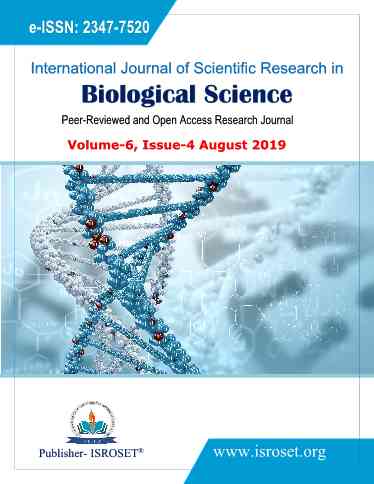Determination of Different Diseases and Preventive Measures of Mulberry Silkworm
Keywords:
Bombyx mori L., Grasserie, FlacherieAbstract
The present study deals with the determination of different disease and preventive measures of mulberry silkworm, (Bombyx mori). Epizootiology, development of immunodiagnostic kit, fluorescent antibody technique and use of ideal disinfectant, chemotherapy and thermo-therapy techniques and management strategies have been addressed for identification, destruction, prevention and control of disease causing micro-organisms. Three years survey was conducted on the incidence of silkworm diseases namely, Grasserie, Flacherie, Muscardine and pebrine, the data revealed that grasserie and flacherie incidence were maximum in summer season and minimum in winter season whereas muscardine was observed high in winter.
References
R. Rao, “Variability in the diseases of hybrids silkworm, Bombyx mori”, Journal of Sericultural Sciences, Mysore, vol. 18, no. 5, (2003), pp. 96-99.
J. Das and T. Shamsuddin. Studied high temperature induced sterility in silkworm Indian Silk. J. Seric. Sci. Japan. Vol. 45, no. 3, (2006), pp. 124-130.
K. Sadhu, and H. Rao. Studied tasar race–Bogai, mylitta with respect to cocoon characters and production technology. J. indust. Ent., Mysore.VOL. 67, no. 2, (2014), pp. 315-340.
T. Savanurmath, and L.Sharma. Selection of diseased and healthy silkworm strain through high temperature rearing of fifth instar larvae. Central Silk, Bangalore, India. Vol. 45, no. 7, (2014), pp.234-241
O. Itushi, “Silkworm nutrition on mulberry plantation in Tokyo”, J. seric.sci, Jpn; vol. 48, no. 8, (2012), pp. 282- 286.
A. Biram and H. Gowda, “Silkworm seed technology”. In Appropriate sericulture technique Central Silk Board, Bangalore, India, vol. 89, no. 4, (2009), pp. 590 –599.
H. Akai, K. Kiguchi and K. Mori, “Increased accumulation of silk protein accompanies KJH-induced prolongation of larval life in Bombyx mori L”. Applied Entomology and Zoology, vol. 67, (1971), pp. 218-220.
H. Akai, K. Kiguchi and K. Mori, “Influence of thiadiazole on the growth and metamorphosis of Bombyx larvae”. Bulletin of the Sericultural Experiment Station of Japan, vol. 32, (1973), pp. 287-305.
H. Akai and K. Kiguchi, “Ultrastructural changes of the posterior silk gland cells from the allata-ectomized 4th-instar larvae of Bombyx mori”. Bulletin of the Sericultural Experiment Station of Japan, vol. 28, (1981), pp. 1-14.
H. Akai, K. Kiguchi, Y. Kobari and A. Shibukawa, “Practical utilization of juvenoids for increasing silk production”. Scientific Papers of the Institute of Organic Physical Chemistry, vol. 22, (1981), pp. 781-792.
H. Akai, K. Kimura, M. Kiuchi and A. Shibukawa, “Effects of anti-juvenoid treatment on cocoon and cocoon filaments in Bombyx mori”. Journal of Sericultural Science of Japan, vol. 53, (1984), pp. 545-546.
C.F. Chang, S. Murakoshi and S. Tamura, “Giant cocoon formation in the silkworm, Bombyx mori L. topically treated with methylenedioxyphenyl derivates”. Agricultural Biology and Chemistry, vol. 36, (1972), pp. 629-694.
S.K. Chowdhary, F. Sehnal, S.K. Raj, P.S. Raju and S. Mathu, “Giant cocoon formation in Bombyx mori L. topically treated with juvenile hormone”. SJ-42-F. Sericologia, vol. 26, (1986), pp. 455-457.
Downloads
Published
How to Cite
Issue
Section
License

This work is licensed under a Creative Commons Attribution 4.0 International License.
Authors contributing to this journal agree to publish their articles under the Creative Commons Attribution 4.0 International License, allowing third parties to share their work (copy, distribute, transmit) and to adapt it, under the condition that the authors are given credit and that in the event of reuse or distribution, the terms of this license are made clear.







